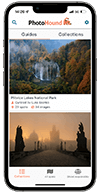Spring is here and it’s that magical time of year when the bluebells start to appear. PhotoHounder and Dorset landscape photographer, Chris Frost, shares his tips on how to photograph bluebells and some of his favourite woodland locations.
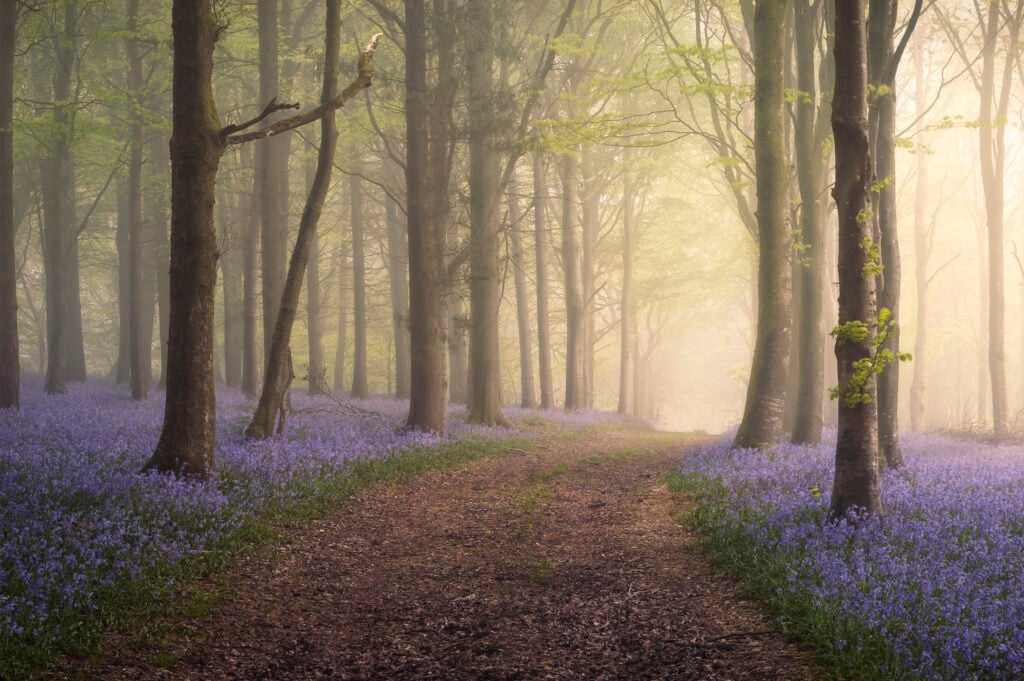
“It takes a strong-willed landscape photographer to resist the allure of spring woodlands carpeted with a sea of bluebells. After winter’s darkness, woodlands long since denuded of leaves, the sudden explosion of colour, aromas and life that Spring delivers can offer an intoxicating experience and the opportunity to capture some truly stunning images. I hope the tips in this article will help you understand how to photograph bluebells and capture these cherished flowers in all their splendour.
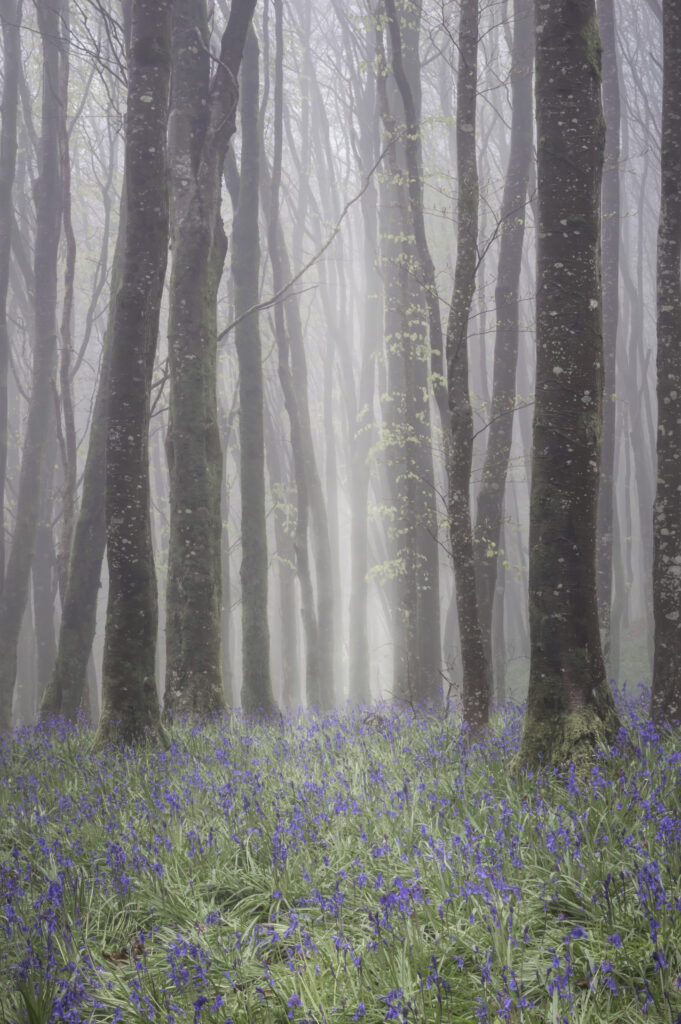
Where to photograph bluebells
Fortunately for those living in the UK, locating a bluebell wood shouldn’t pose a problem as it is home to half the world’s bluebell population. Bluebells bloom between mid-April and mid-May but locations vary year on year dependent on that winter’s severity; visit too early and the display will be patchy and uninspiring, too late and flowerheads will have drooped or potentially been trampled. Keeping an eye of social media platforms is a good way of staying abreast of how your local area’s display is progressing, but nothing beats getting out and scouting potential locations. If you’ve found a great woodland for photography, remember you can add it to PhotoHound for others to enjoy!
Look for ancient and mixed woodland areas
Bluebells thrive in partial shade and are commonly found under deciduous trees such as oak and beech. They normally flower before the woodland canopy has become too dense and started blocking much needed light. Therefore, you should focus on ancient and mixed woodlands areas dominated by deciduous trees. Bluebells are fairly invasive and often migrate across areas. Scouting smaller woods close to larger well-known bluebells locations can therefore pay dividends. You might be lucky and stumble upon unseen gems.
Get to know a location well
Scouting is particularly valuable for woodland locations where finding cohesion can be an unenviable task. It will also make the following tips far more achievable. Scouting without the specific goal of creating a shot is a fantastic way to spend a couple of peaceful hours. It can often free the mind to see compositions you might otherwise miss. Knowing a woodland location well will give you a head start when the conditions are right. You’ll be more likely to know where you might find mist and fog. You’ll be better able to utilise these special conditions with pre-visualised compositions when bluebells are at their most prevalent.
Have patience and options
Having a number of potential compositions in hand can allow you to work effectively with the available light and conditions. Remember patience is key; find a subject, take your time, try different lenses, perspectives and styles. You may be pleasantly surprised by the quality of images produced. One excellent image you’re truly happy with will always trump three so-so images.
You will find some of the images in this post in my PhotoHound Guide to Dorset. You can also search using the keyword ‘bluebell’ to find more locations on the PhotoHound map.
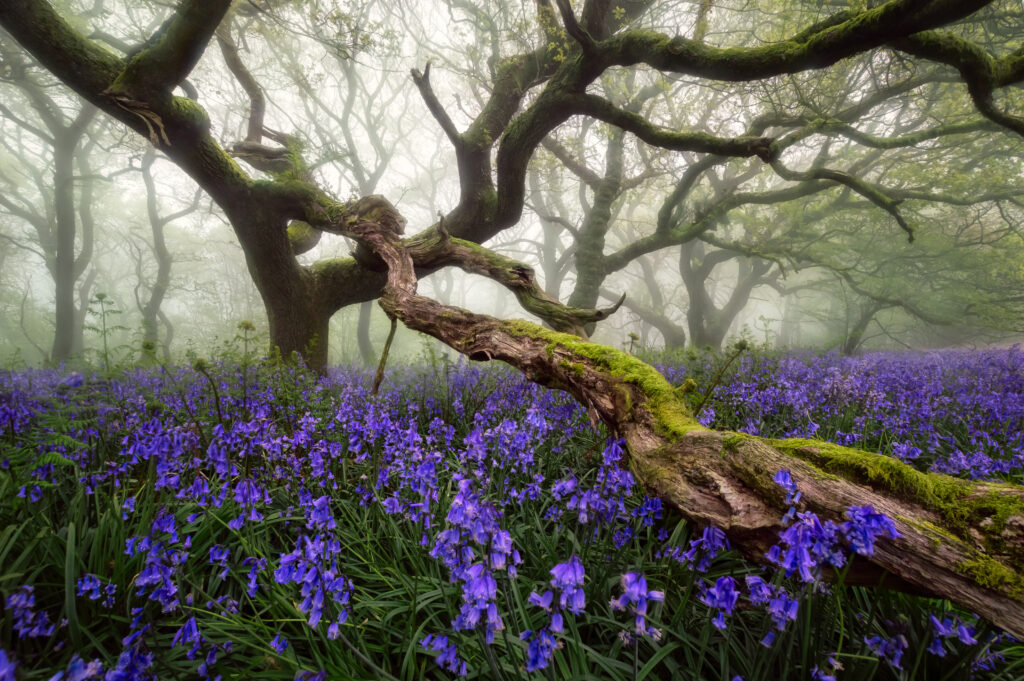
Ideal shooting conditions
Woodland imagery is tricky and often very reliant on weather conditions. However, an explosion of bluebells will transform an untidy or bland woodland floor into a stunning sea of purples and blues. That said, certain environmental conditions will assist in the task of creating compelling images.
Mist and fog
Woodlands and fog are a match made in heaven. Foggy scenes instantly reduce clutter, blur and soften the background. This in turn places emphasis on key foreground subjects and softens the sometimes-overpowering colours of a bluebell scene. Swirling mists deliver atmosphere in bucket loads turning ordinary scenes into something magical. This is especially true when the sun climbs higher and rays pierce the canopy, softly warming the lingering mists.
Overcast days
Fog may be the Holy Grail of woodland photography, but overcast and rainy days are also ideal for visiting woodlands. The canopy provides shelter and overcast conditions can soften and subdue light. This will flood the scene with added vibrance and a sense of freshness. Use a polariser in these conditions, especially after rainfall, and bluebell and foliage colours will pop from the scene.
Sunlit clearings
Clear days and a high sun bring harsh and contrasty light. This is equally true in woodlands as spattered light will add to any disorder and confusion in a scene. It will also bleach out the bluebells’ colour. However, there are exceptions which make these conditions worthy of venturing out. Locating a small clearing, an interesting tree surrounded by bluebells and heavy surrounding foliage. When light enters such a clearing, spotlighting the centrepiece, it can lead to some truly unique and stunning images. Otherwise, venture out early or late when the sun is at its lowest. Capture the light as it softly paints tree edges whilst shadows creep across the bluebell carpeted floor. This will add depth, drama and interest to the scene.
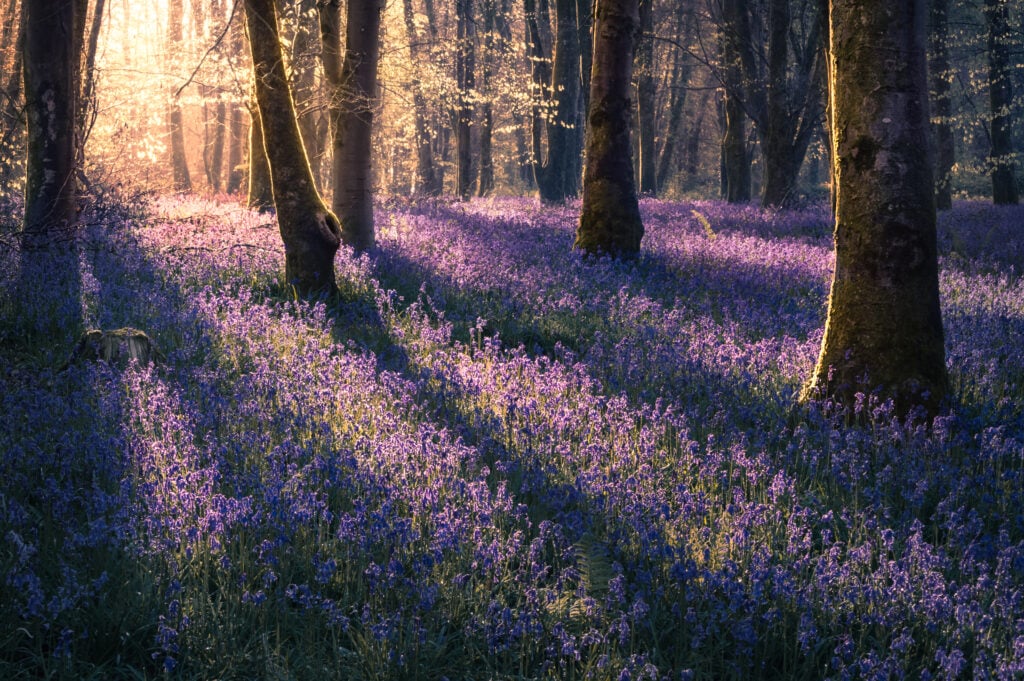
Suggested gear for a bluebell shoot
Many advocate zoom lenses for woodland photography. They do offer great flexibility and simplify the task of pulling clarity from the woodland, but other lenses can open up creative opportunities. Experiment and capture images a little different from the norm. Think about the merits of each lens and the style you intend to shoot as you pack your bag. Remember that due to lower light levels in woodlands, a tripod and cable release are also beneficial.
Telephoto Lenses
The versatility of a zoom lens allows compositional flexibility. You can easily crop distracting elements from a scene and the positive effect of compression will bring subjects closer together; this can prove especially important when you want to convey a sense of a densely populated woodland floor – an uninterrupted sea of bluebells. They are also very useful for isolating single flowers or clumps of flowers for more intimate images, where a wide aperture will blur the background to a wash of colour placing all focus on the subject matter.
35/50mm Prime Lenses
Prime lenses make you work a little, but their inherent sharpness and similarity to how we see the world make them a worthwhile addition to the bag. Not only are they great for shooting more intimate scenes with wide apertures (f/2.8/f/4) allowing subject isolation, but they also force you to move around and look for compositions rather than use the zoom to change perspective.
Wide-angle Lenses
A wide-angle lens may have its limitations, but it can deliver some of the most striking and unique bluebell imagery as the grand vista fills the image. Do beware that the lack of image compression can result in the flowers appearing spread-out and less dense, potentially diminishing the scene’s impact. To negate this, shoot low and close to the flowers accentuating their heads and giving them greater prominence in the image which will also narrow the visual perception of gaps between bluebells. The wide-angle lens is more effective in cleaner woodlands where debris and distraction are less obvious.
Macro Lens
Some of the most beautiful and artistic images are those captured on macro lenses. These intricate little flowers are a perfect muse for the miniature world of macro photography and a pleasant diversion from the more typical vistas flooding social media. A word of warning, even the slightest breeze can cause havoc and lead to a memory card full of blurred flowers.
Polariser
Polarisers can drastically change a woodland scene by removing the natural shine on foliage and saturating their vivid colours. This is especially true of bluebells, the filter’s effect giving them a huge punch of vibrancy but be careful as the combined effect of polarisation and the dark forest conditions will necessitate extended shutter speeds. Slower shutter speeds work well for seascapes, but even a slight zephyr will result in blurred branches, leaves and importantly, bluebells. Details that should be sharp can massively detract from the final image when not; a lesson I have learnt the hard way…on more than one occasion. Increasing the ISO will allow for adequate shutter speeds to be maintained in most situations.
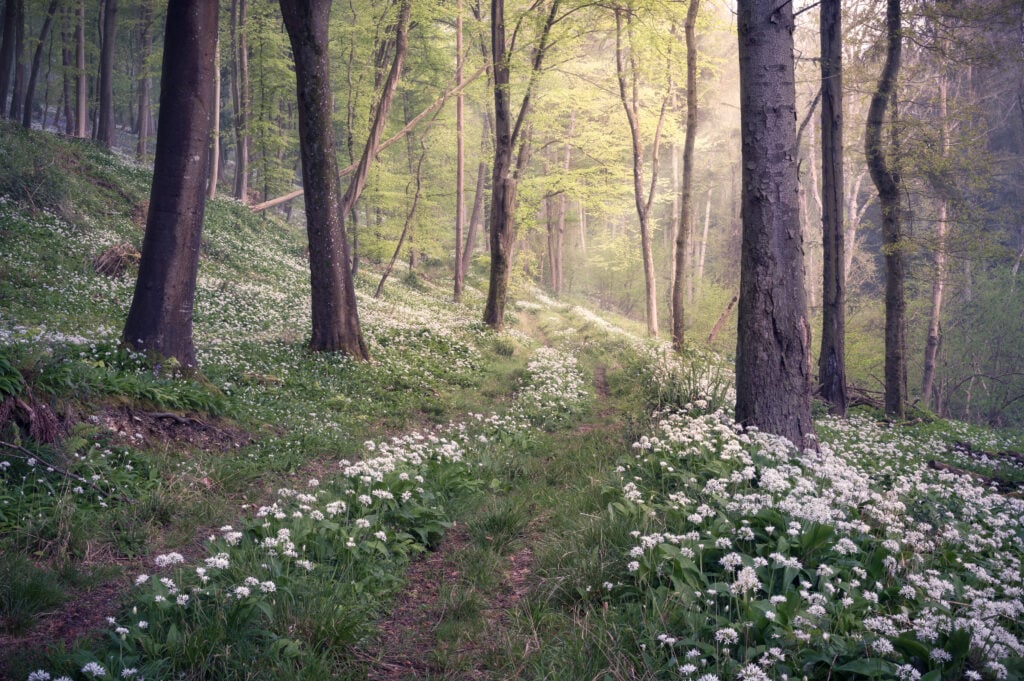
Shooting Tips
Tell a story
Some bemoan bluebell photography as clichéd; a sea of purple intersected by tall straight beech trunks reaching skywards. As stunning as a bluebell display is, it is important to create a composition that offers interest and structure. Fortunately, bluebells favour old woodlands, locations where a little searching can uncover characterful trees and an opportunity for unique images. A lonely old oak contrasted against a sea of fresh bluebells gives the picture reference and a story, and in the right conditions can be very evocative.
Aperture
With the exception of sunstars, in woodlands the sweet spot for shooting apertures is between f8-f14. This avoids loss of clarity caused by distraction associated with smaller apertures. Using larger apertures can result in backgrounds losing some sharpness, but woodland photography is forgiving in this area. A slight softening as the image moves away from the primary focal points into a sea of purple can be pleasing, mimicking the way the human eye sees.
Look for leading lines
Use pathways, tracks and tree tunnels to act as leading lines. Natural or man-made paths are effective in leading the viewer through the image, especially when meandering through a dense forest scene. Pathways are likely to have more light streaming through than the surrounding areas and this comparative brightness further helps composition as the eye is naturally drawn to lighter, warmer areas of an image. Using, and staying on, these paths will also help protect the bluebell display for future years.
Light
Look at how the light falls and interacts with certain elements of the scene. Some images may work better, or only work, when the light is in a certain position. The soft highlighting of details will add depth and three-dimensionality, bringing subjects to life. Golden hour’s low warm light will cast long shadows across the flower carpet, and can be used as effective leading lines, again providing depth to the image.
Depth
Depth is key to woodland and bluebell photography and allows you to achieve that ‘I feel like I could step into the image’ feeling, but without it images can look flat and messy. You can create that perception with leading lines, shadow and light, or a shift from cool to warmer tones. All of these will draw the eye through the image and from subject to subject.
Sunstars and sunrays
Sunstars and sunrays are particularly pleasing and effective for bluebells woods, bringing additional impact to an image. Get sunstars by shooting with small apertures between f16-f22 and partially obscure the sun behind distant tree trunks. Sunrays can be more elusive and are normally found around an hour after sunrise when the sun has risen high enough to penetrate and burn off overnight moisture. The evaporating moisture creates thin localised mists which can be illuminated with shafts of sunlight creating some truly magical effects as they illuminate certain areas of the woodland floor.
Careful composition selection
Compose images in areas of cleaner undergrowth. There is nothing more frustrating than returning home to realise winning images on the camera screen, are spoiled by debris littering the woodland floor, as are key elements or distractions spilling over image edges. Wherever possible, try to eliminate all or as much of the visible sky as possible. This won’t always be possible, especially as bluebells prefer areas of dappled light, but patches of sky or light peeking through can cause unsightly contrast and distraction.
Experiment
Shoot wide open (f/2.8 or f/4), focusing on a foreground elements of interest as the rest of the image spills out of focus into a blanket of soft colours.
Attempt intentional camera movement (ICM) where the camera is deliberately moved in an upwards motion as the image is being taken. Somewhat of a dark art that I am yet to master, but this technique can deliver unique and pleasing art.
Incorporate other plant life into a scene, such as wild garlic. Contrast the blue and white against the standard woodland palette. In Dorset at least, it seems like wild garlic patches are becoming more prevalent and these fields of white offer a nice change from the usual bluebell scenes of Spring.
Get low and close to the flowers. A wide-angle lens will exaggerate the size of flowerheads in close proximity, giving them dominance while also narrowing the gap between mid to background flowers and increasing their perceived denseness.
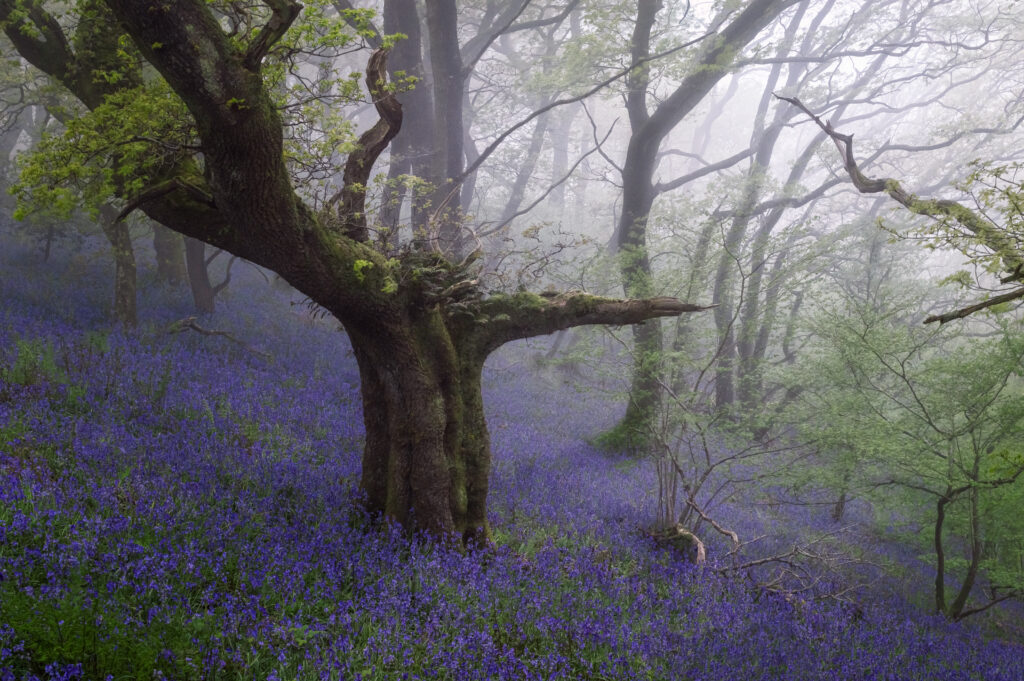
Technical Tips
Pay attention to the histogram. Light streaming into bluebell woods can cause high contrast and tricky shooting conditions but reviewing the histogram (including the blue channel) should make this task more manageable.
Expose to the right. Bluebell woods are normally shadow heavy locations, so in exposing to the right you maximise the chance of capturing the tonal information of the mid and highlights, reduce noise and subsequently increase image quality. The theory specifics are readily available on the internet but entails pushing the histogram peak as far to the right as possible whilst importantly ensuring the highlights are not clipped.
Where available, shoot in RAW format. Cameras not only struggle with wide luminosity ranges but can also see colours in a different way to our own eyes; bluebell hues often look very different on the computer monitor to your recollection of the day. Shooting in RAW will provide full flexibility to brings those hues back in line with how you recall or wish to convey them.
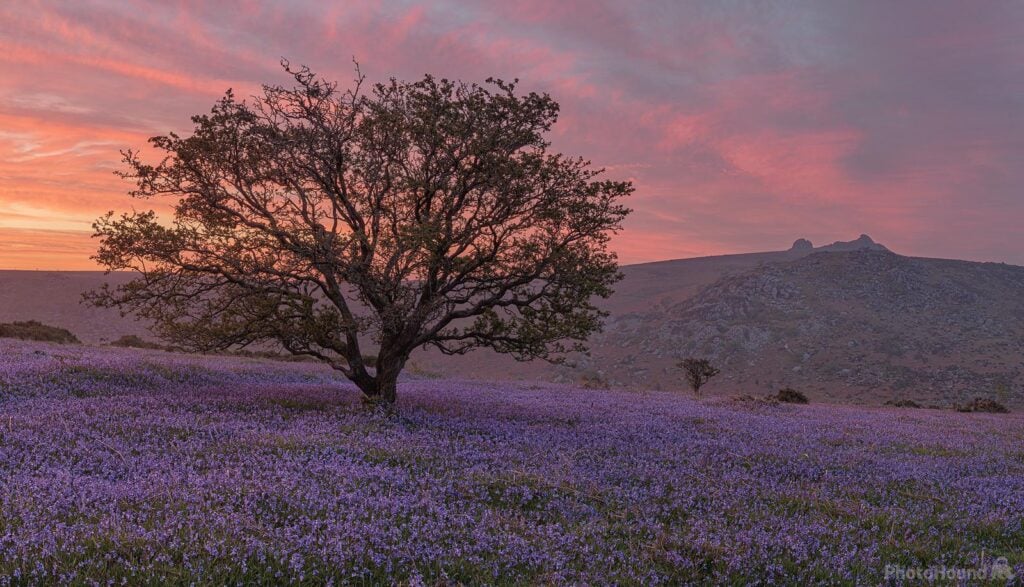
A Final Note on Shooting Bluebells
Enjoy the experience!
Woodland photography is an undeniably difficult genre, but spring’s impressive floral displays make this a far easier task. Don’t be discouraged if your images don’t match up to some of those on social media. Rather than trying to replicate, look for unique compositions and try to ensure the image has more interest than just the bluebells themselves. All to often Mother Nature works against us and perfect compositions are spoiled by harsh lighting. Simply earmark these locations for a future visit. Enjoy the time you spend shooting bluebells; slow down, breathe in the bluebells and pungent wild garlic.
Shoot bluebells responsibly
Finally, remember to take care of the bluebells and tread lightly wherever you shoot. Aim to leave the location a little better than you found it. This is particularly relevant to bluebells which are delicate and easily damaged, and as the plant can take up to seven years to become established, even minor damage can have long-lasting impact. This is something strongly championed by PhotoHound in their Responsible Photography Principles. Woodlands and forests are usually areas of pristine natural beauty and we want them to stay that way. Watch your step and don’t cause any damage to the woodland floor or wildflowers. Never be tempted to ‘clean’ a scene by breaking branches or moving natural objects; instead move yourself and find another angle. Place your tripod and gear bag carefully.
Personally I would never place a model among bluebells, but if you are doing portrait photography, find a clearing or natural pathway for your model to stand on.”
We hope you enjoy these tips on how to photograph bluebells in the UK. Find more amazing woodland locations around the world on PhotoHound. Our thanks to Chris Frost for this detailed article. Check out more of his work here and follow him on PhotoHound.
